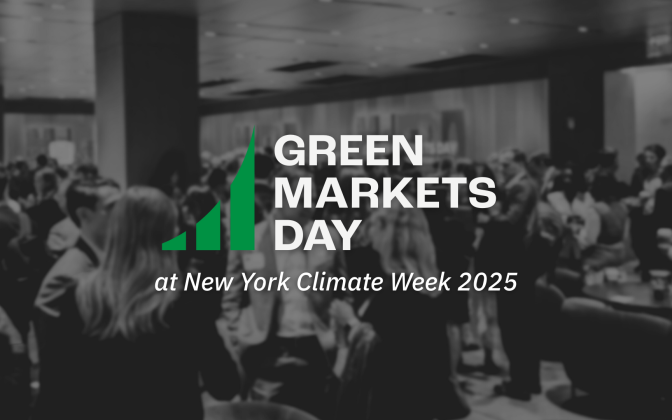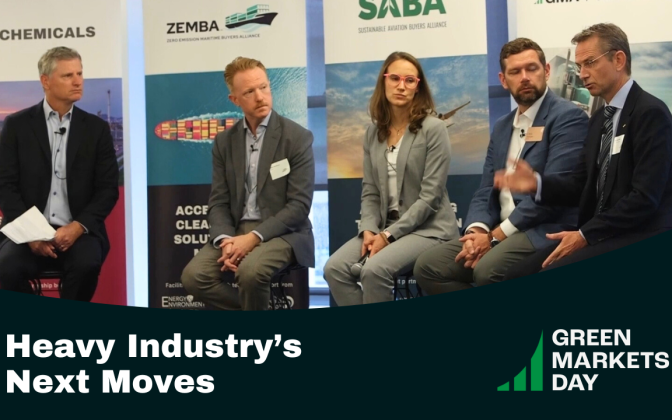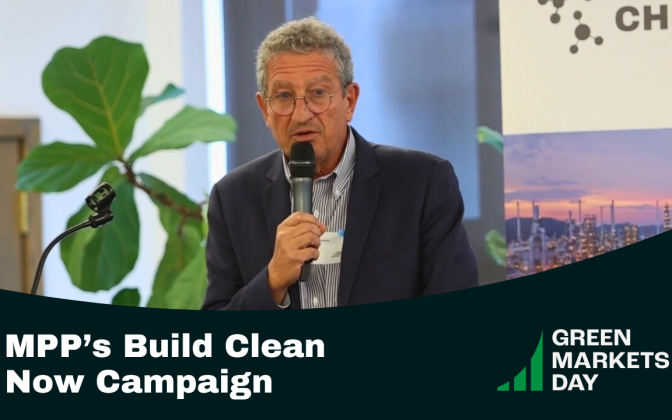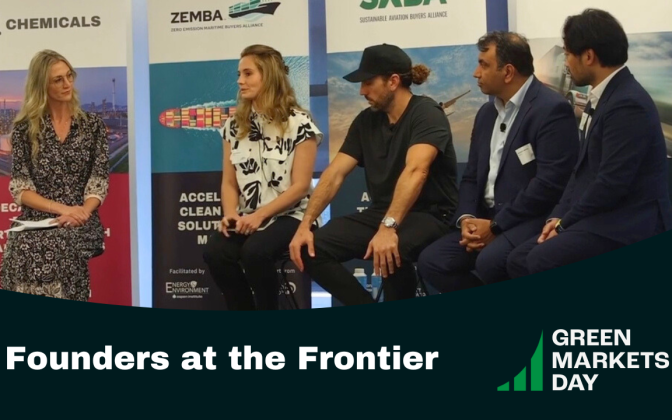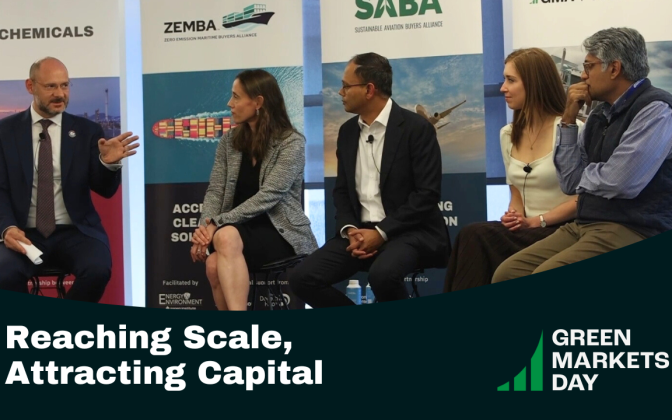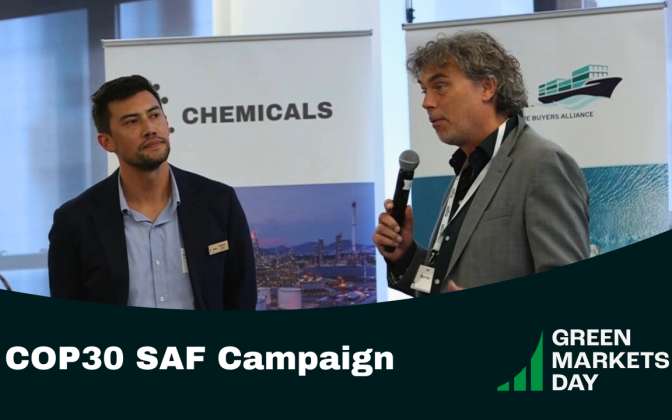10.29.25
Green Markets Day 2025 – Welcome and State of the Market
Kim Carnahan, CEO of the Center for Green Market Activation, welcomed attendees at the top of Green Markets Day 2025.
See below for a full transcript.
KIM CARNAHAN:
I’m Kim Carnahan. I’m the CEO of the Center for Green Market Activation, or GMA, as we call ourselves. Together with our co-organizers, RMI, Smart Freight Centre, and Lowercarbon Capital, I want to welcome you to the second annual Green Markets Day.
If you’ve never heard — [applause] woo! That’s nice. If you’ve never heard of GMA or think it stands for Good Morning America like my mom, that’s okay. Don’t worry. I’m going to fill you in.
We’re a US-based, globally-focused nonprofit with the mission of catalyzing markets for low-carbon fuels, materials, and services in the world’s hardest to abate sectors, particularly heavy industry and transport.
We partner with other nonprofits to stand up sector-specific buyers alliances and sector-specific book and claim systems.
Our buyers alliances aggregate corporate demand, take it to market, and support our member companies all the way through contracting and delivery.
While procurements through book and claim are central to our demand aggregation approach, we are fast moving towards supporting physical procurements as well for some of our buyers.
Now, if you don’t know GMA well, then you probably don’t know our staff very well either. We have grown from 4 to 24 in the past year, and we are very nerdy.
Let me share this scenario with you. For our first ever team retreat, we went to sunny Mexico in January. In their spare time, my team could have been relaxing here. But instead, I found them here arguing about GHG accounting methods. I have no idea where they found that flip chart, but I was so proud of them for it.
Don’t worry, we didn’t let them set the whole program today, though.
We do have a lot to cover in the next five hours, but before we get to it, I want to do a little bit of a review of some of the really good stuff that’s happened over the last year.
Let’s start with chemicals. GMA and RMI chemicals teams have joined forces and launched two new buyers programs, one focused on green ammonia-based fertilizer and the other on low-carbon ethylene and ethylene plastic products. We released our first RFI just last Friday for low-carbon ethylene.
As an aside, most companies think they don’t care about ethylene. I’m not sure I knew what ethylene was before we started our chemicals program. But most companies care a lot about plastics and decarbonizing plastics and reducing their use of plastics. And they have literally tons of it in their greenhouse gas inventory. So even though it is very nerdy, we’re excited about this ethylene program.
Moving on to concrete, a sector I realized I talk about too much because my two-year-old squeals more when he sees concrete trucks than when he sees ice cream trucks. The joint GMA/RMI working group on concrete has now published a draft framework for a book and claim system for clinker, cement, and concrete. It should be finalized by the end of the year, enabling us to move forward towards registry design.
And spoiler alert, we are, in just a few hours, going to announce the first or the launching of the Sustainable Concrete Buyers Alliance, or SCoBA.
GMA Trucking also has a big announcement today. The winning operator of its first ever collective procurement for heavy-duty EV trucking will be revealed here in about an hour, so stay put. Smart Freight Centre has made great progress on its I-10 coalition and ZET SCALE programs this last year, and our partners RMI have their sustainable steel buyers platform. They’re proceeding to bilateral conversations with producers and laying the groundwork for a new RFP in the Asia-Pacific region next year.
I’m going to spend just a tad more time talking about the kind of elder statesmen of the buyers alliances that GMA has the pleasure of supporting. The Zero Emission Maritime Buyers Alliance, managed by our friends at the Aspen Institute, has been running a marathon at a sprint’s pace over the past 12 months. They now have over 45 members and are nearing the finish line in their second tender, which is focusing exclusively on e-fuels, achieving a greater than 90% reduction in emissions compared to fossil baseline. The winner will be announced around the end of this year.
The Sustainable Aviation Buyers Alliance, which launched with RMI and EDF way back in 2021, has set up a new two-track approach to supporting our members’ procurement. The first track is SAFc Connect. It’s a secure online platform that connects corporate buyers with SAF fully vetted by SABA and available today.
The second track is SABA’s Next Gen Procurement. It is aimed at providing an avenue for buyers to engage in multi-year advanced market commitments and drive deployment of e-fuels and advanced biofuels.
In addition to those member-only procurements, SABA is also launching a brand-new platform that enables anyone to address travel emissions to specific events with a few easy clicks. We’re starting with COP 30, and you’re going to hear more about that a little bit later today.
So that was a lot of progress, but I would be seriously remiss if I didn’t highlight in this year-end review all the hoopla surrounding GHG accounting and target setting standards this last year. Because most of the climate action that we’re going to be talking about in this room depends on getting that right.
Let’s start with the AIM platform. It was launched almost 2 1/2 years ago now to fill a gap in the existing standards landscape. The fact that companies didn’t have the ability to account for and report on most of the value chain decarbonization investments that they were making. And that was seriously dis-incentivizing action.
The output of AIM’s work has been released in two chunks this year. The last half was released just last week, is now out for stakeholder comment, and is being piloted by over 20 global companies. And thank goodness we managed to finish that work when we did, because as you all know, I am sure, the GHG protocol and the Science-Based Targets Initiative, the true standard bearers in this space, both began in-depth revision processes over the last year.
Who else read SBTI’s V2 corporate net zero standard the day it came out? ChatGPT doesn’t count. OK, still Devin. We’re alone here. If any of you didn’t ever make it through those 133 pages, we’ve got you. We definitely did.
We also have a great lineup for you today. From some of the most exciting startups out there to our standards to bona fide climate celebrity folks, we’ve got David Roberts from Volts here with us today. Very exciting. It’s going to be a great afternoon.
The theme of this year’s Green Markets Day is Signals That Move Markets. And standard setters definitely fit the bill, which is why we’re starting our day with them.
Before we get going, I want to take this opportunity to thank my truly amazing team at GMA, our teams that we work with so closely at RMI, Smart Freight Centre, Aspen Institute, and Environmental Defense Fund. I want to thank the GMA member companies who use the stuff we build and the philanthropic donors who make it possible for us to build them. And finally, I want to thank Lowercarbon Capital for helping make this event a reality today.




